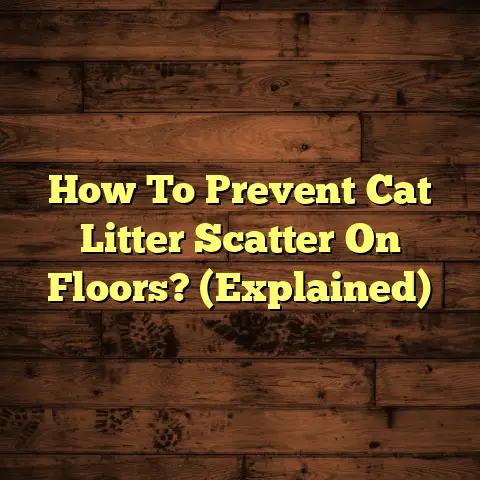Strip & Wax Floors Like A Pro (4 Steps Only!)
And trust me, the difference is night and day.
With the seasons changing, especially as we head into spring or gear up for the holidays, I always get a ton of questions about how to keep floors looking their best.
Right now, everyone’s thinking about spring cleaning,
or prepping their homes for holiday gatherings, and guess what?
Floors are a HUGE part of that!
Think about it: a sparkling floor instantly elevates the entire space.
And let’s be honest, who wants guests tracking dirt across a grungy surface?
But it’s not just about looks, folks.
A well-maintained floor is a safer floor.
Stripping and waxing is a routine maintenance practice that not only prolongs
the life of the flooring but also improves safety by reducing slips and falls.
That waxy buildup?
It can actually create a slippery surface.
Not ideal for kids running around or even just navigating your own home.
Now, stripping and waxing might sound like a daunting task,
something best left to the pros.
But I’m here to tell you, it doesn’t have to be!
I’m going to break down the process into four super simple steps
that anyone can follow.
Whether you’re dealing with vinyl in your kitchen,
linoleum in your shop, or tile in your business, you can achieve
professional-looking results without breaking the bank.
My goal is to give you a straightforward, easy-to-follow method to strip
and wax your floors efficiently in just four steps, ensuring professional results
without the need for hiring a service.
So, grab your gloves, and let’s get started!
Section 1: Understanding the Basics of Floor Stripping and Waxing
Alright, let’s dive into the nitty-gritty.
What exactly is stripping and waxing?
And why do we even bother?
Simply put, stripping is the process of removing old layers
of wax, dirt, and buildup from your floor.
Think of it as hitting the reset button.
Over time, wax layers accumulate dirt, scuffs, and become discolored.
Stripping gets rid of all that gunk, giving you a clean slate.
Waxing, on the other hand, is the process of applying a fresh,
protective layer of wax or floor finish.
This new layer not only makes
your floor shine but also acts as a barrier against future damage.
It’s like giving your floor a shield against everyday wear and tear.
So, why is this combo so important?
Well, stripping and waxing
does three major things:
-
Restores Shine: Brings back that “like new” luster.
-
Extends Lifespan: Protects the flooring material from damage.
-
Improves Safety: Creates a smoother, less slippery surface.
Now, not all floors are created equal.
Stripping and waxing is ideal for certain types
of flooring, but it can be a disaster for others.
Here’s a quick rundown:
Yes to Stripping & Waxing:
Vinyl Composition Tile (VCT): This is the most common type.
VCT is practically made for stripping and waxing.-
Linoleum: A natural and resilient option that benefits from regular maintenance.
-
Sheet Vinyl: Some types of sheet vinyl can be stripped and waxed, but always check the manufacturer’s instructions first.
-
Certain Types of Tile: Quarry tile and some other unglazed tiles can be treated.
No-Go Zones:
Hardwood: Stripping and waxing hardwood is a BIG no-no.
You’ll ruin the finish and potentially damage the wood.-
Laminate: Similar to hardwood, laminate doesn’t play well with these processes.
-
Carpet: Obvious, but worth mentioning!
-
Natural Stone (Marble, Granite): These require specialized cleaning and polishing methods.
Pro Tip: If you’re unsure about your floor type, consult a flooring professional
or check the manufacturer’s website.
Better safe than sorry!
Section 2: Essential Tools and Materials
Okay, now that we know the what and why, let’s talk about the how.
To strip and wax like a pro, you need the right tools and materials.
Trying to cut corners here will only lead to frustration and subpar results.
Trust me, I’ve been there!
Here’s a comprehensive list of what you’ll need:
Tools:
Floor Stripper: This is your workhorse.
Choose a stripper specifically designed for your floor type.
I’ll recommend some good options later.Wax or Finish: Again, the type of wax or finish matters.
Acrylic finishes are popular for their durability and shine.-
Mop and Bucket (x2): You’ll need one for applying the stripper/wax and another for rinsing.
Floor Buffer or Polisher: This is where you get that professional-grade shine.
A rotary floor machine is ideal, but you can also use a scrub brush with a handle.-
Scrub Brushes: For those stubborn areas and corners.
-
Wet/Dry Vacuum: Essential for picking up the dirty stripper solution.
Safety Gear: Don’t skimp on this!
Gloves, goggles, and a mask are crucial to protect yourself from chemicals.
Recommended Products:
Alright, let’s get specific.
I’ve used a ton of different products over the years,
and these are some of my go-to’s:
Why Choosing the Right Products Matters:
Using the wrong products can lead to a whole host of problems:
-
Ineffective Stripping: The old wax won’t come off properly, leaving you with a sticky mess.
-
Damaged Flooring: Harsh chemicals can damage the surface of your floor.
-
Poor Finish: The wax might not adhere properly, resulting in a dull or uneven shine.
-
Health Hazards: Using products without proper ventilation or safety gear can be dangerous.
My Story: I once tried to save a few bucks by using a cheap floor stripper
on a VCT floor.
Big mistake!
It barely removed any of the old wax,
and the fumes were unbearable.
I ended up having to redo the entire job
with a professional-grade stripper, which cost me even more money in the long run.
Pro Tip: Read the labels carefully and follow the manufacturer’s instructions.
And don’t be afraid to spend a little extra on quality products.
It’ll save you time, money, and headaches in the long run.
Section 3: Step-by-Step Guide to Stripping and Waxing Floors
Okay, team, it’s showtime!
We’ve got our tools, we’ve got our materials,
and we’ve got the knowledge.
Now, let’s get those floors looking amazing.
Remember, patience is key here. Don’t rush the process, and follow each step carefully.
Step 1: Preparing the Area
This is arguably the most important step.
Proper prep work sets the stage
for a successful stripping and waxing job.
Clear the Room: Remove all furniture, rugs, and obstacles from the area.
This includes small items like trash cans and doormats.Sweep and Vacuum: Thoroughly sweep or vacuum the entire floor to remove any loose dirt, dust, or debris.
Pay extra attention to corners and edges.-
Protect Surrounding Areas: Use painter’s tape and plastic sheeting to protect baseboards, walls, and any other areas you don’t want to get stripper or wax on.
Ventilate the Area: Open windows and doors to provide adequate ventilation.
Strippers and waxes can have strong odors, so good airflow is essential.
Step 2: Stripping the Floor
Now for the fun part!
Dilute the Stripper: Follow the manufacturer’s instructions for diluting the floor stripper with water.
The dilution ratio will vary depending on the product and the severity of the wax buildup.- Light Buildup: 1 part stripper to 4 parts water.
- Moderate Buildup: 1 part stripper to 2 parts water.
- Heavy Buildup: Use full strength or very little water.
Apply the Stripper: Using a clean mop, apply the stripper solution to the floor in a thin, even layer.
Work in manageable sections (e.g., 10×10 feet) to prevent the stripper from drying out.Dwell Time: Allow the stripper to dwell on the floor for the recommended amount of time.
This is crucial for breaking down the old wax.
Check the product label for specific dwell times, but typically it’s around 10-15 minutes.Scrubbing Action: After the dwell time, use a floor buffer or scrub brush to agitate the stripper and loosen the old wax.
If using a floor buffer, use a stripping pad (usually black or dark brown).
If using a scrub brush, apply firm, even pressure.Remove the Stripper: Use a wet/dry vacuum to remove the dirty stripper solution from the floor.
You can also use a mop and bucket, but a vacuum is more efficient.
Step 3: Rinsing and Drying
This step is often overlooked, but it’s essential for ensuring a clean, wax-ready surface.
Rinse Thoroughly: Fill a clean bucket with fresh water and use a clean mop to rinse the floor thoroughly.
Repeat this process several times until all traces of the stripper are gone.Neutralize (Optional): Some strippers can leave a residue that can interfere with the wax.
To neutralize the floor, mix a mild acid solution (e.g., vinegar and water) and mop it onto the floor.
Then, rinse again with fresh water.Allow to Dry Completely: This is crucial!
Before you even think about waxing, the floor must be completely dry.
Use fans or open windows to speed up the drying process.
This can take anywhere from 30 minutes to several hours, depending on the humidity and ventilation.
Step 4: Waxing the Floor
Alright, we’re in the home stretch!
Apply the Wax: Using a clean mop or wax applicator, apply a thin, even layer of wax or floor finish to the floor.
Again, work in manageable sections.Number of Coats: Most floors require at least two coats of wax for optimal results.
Allow each coat to dry completely before applying the next.
Drying times will vary depending on the product, but typically it’s around 30-60 minutes.Buffing (Optional): After the final coat of wax has dried, use a floor buffer with a polishing pad (usually white or beige) to achieve a high-gloss finish.
This step is optional, but it will definitely enhance the shine.
My Story: I once rushed the drying process and applied wax to a slightly damp floor.
The result was a cloudy, uneven finish that looked terrible.
I had to strip the floor again
and start over!
Lesson learned: patience is a virtue.
Pro Tip: Apply the wax in thin, even layers.
Avoid applying too much wax at once,
as this can lead to streaks and uneven drying.
Section 4: Post-Wax Maintenance and Care
Congratulations!
You’ve successfully stripped and waxed your floors like a pro.
But the job’s not over yet.
Proper maintenance is key to keeping your floors
looking their best for years to come.
Here are a few essential tips:
Routine Cleaning: Sweep or vacuum your floors regularly to remove dirt and debris.
Use a damp mop with a neutral floor cleaner to clean the floors as needed.
Avoid using harsh chemicals or abrasive cleaners, as these can damage the wax finish.Use Floor Mats: Place floor mats at entrances to trap dirt and moisture.
This will help protect your floors from wear and tear.Avoid Heavy Traffic: If possible, avoid heavy traffic on newly waxed floors for at least 24 hours.
This will give the wax time to fully cure.Regular Burnishing: Burnishing is the process of using a high-speed floor buffer to polish the wax finish.
This can help maintain the shine and extend the life of the wax.
Signs It’s Time to Re-strip and Re-wax:
Even with proper maintenance, your floors will eventually need to be re-stripped
and re-waxed.
Here are some signs that it’s time:
-
Dull Appearance: The floor no longer has a shine, even after cleaning.
-
Scratches and Scuffs: The wax finish is heavily scratched or scuffed.
-
Embedded Dirt: Dirt and grime are embedded in the wax finish and cannot be removed with regular cleaning.
-
Yellowing or Discoloration: The wax finish has yellowed or become discolored.
-
Peeling or Flaking: The wax finish is peeling or flaking off the floor.
Pro Tip: The frequency of stripping and waxing will depend on the amount of traffic
your floors receive.
In high-traffic areas, you may need to strip and wax every 6-12 months.
In low-traffic areas, you may only need to do it every 1-2 years.
Conclusion
And there you have it!
Stripping and waxing floors like a pro is totally achievable
in just four simple steps.
Let’s recap:
- Prepare the Area: Clear the room, sweep, and protect surrounding areas.
- Strip the Floor: Apply stripper, dwell, scrub, and remove.
- Rinse and Dry: Rinse thoroughly and allow to dry completely.
- Wax the Floor: Apply thin coats of wax and buff (optional).
I know it might seem like a lot of work, but trust me, the results are worth it.
There’s nothing quite like the feeling of stepping onto a freshly stripped and waxed floor.
It’s clean, it’s shiny, and it makes the whole space feel brand new.
So, go ahead, give it a try!
Take pride in your flooring maintenance,
and enjoy the benefits of a beautifully polished floor in your home or business.
You’ve got this!





